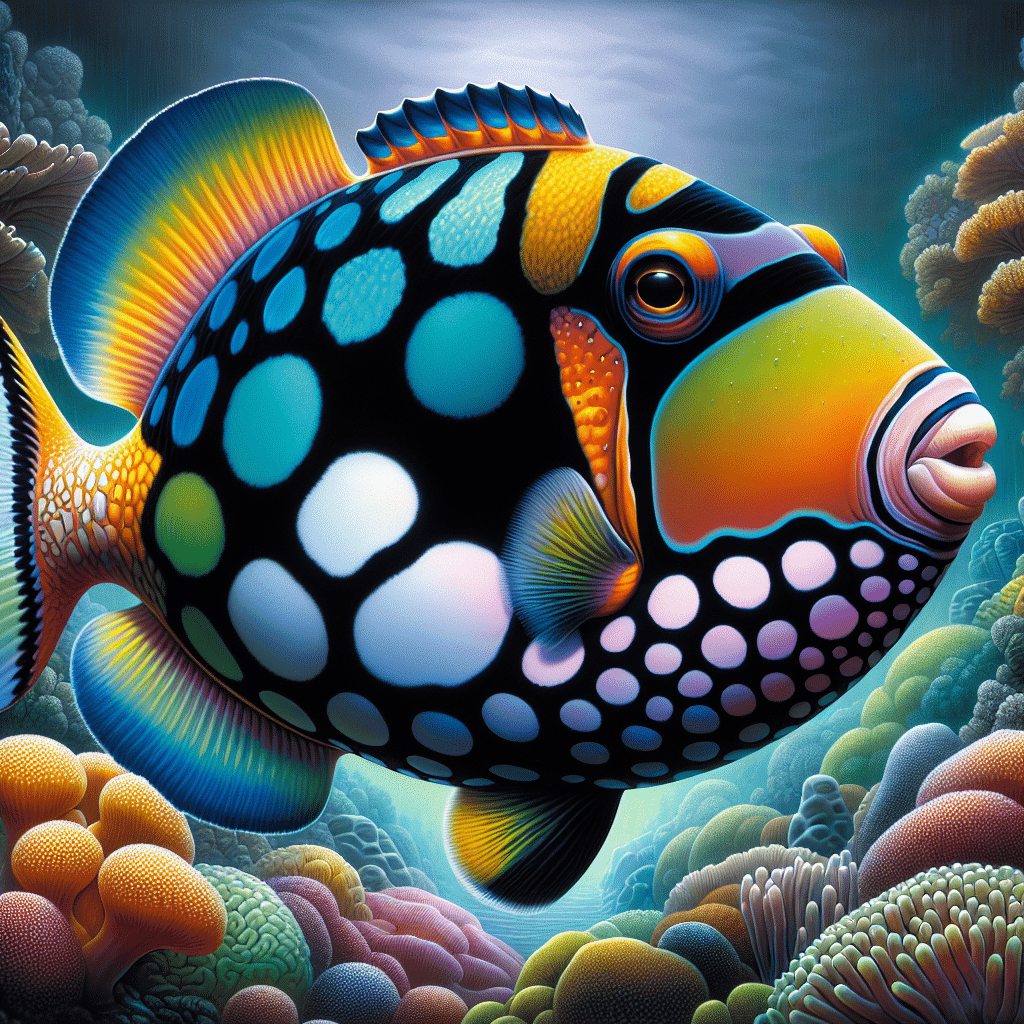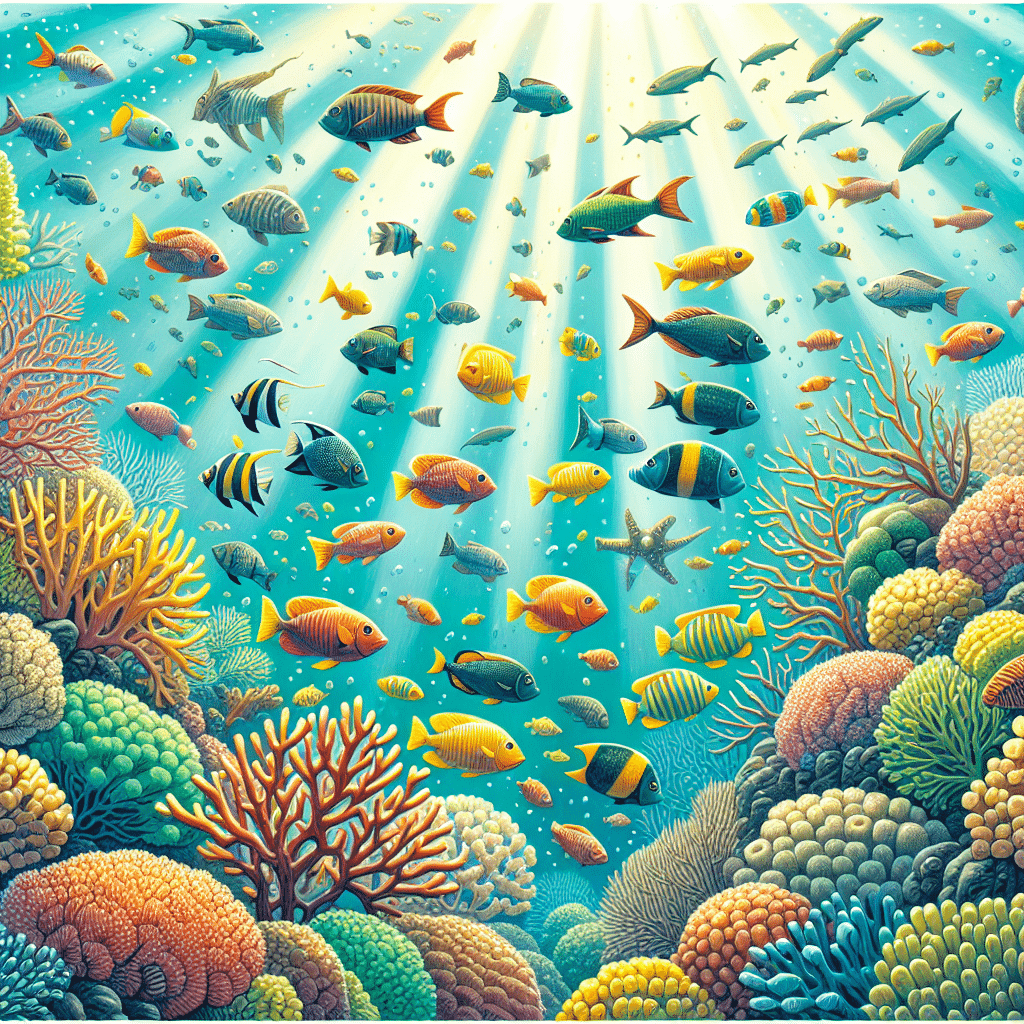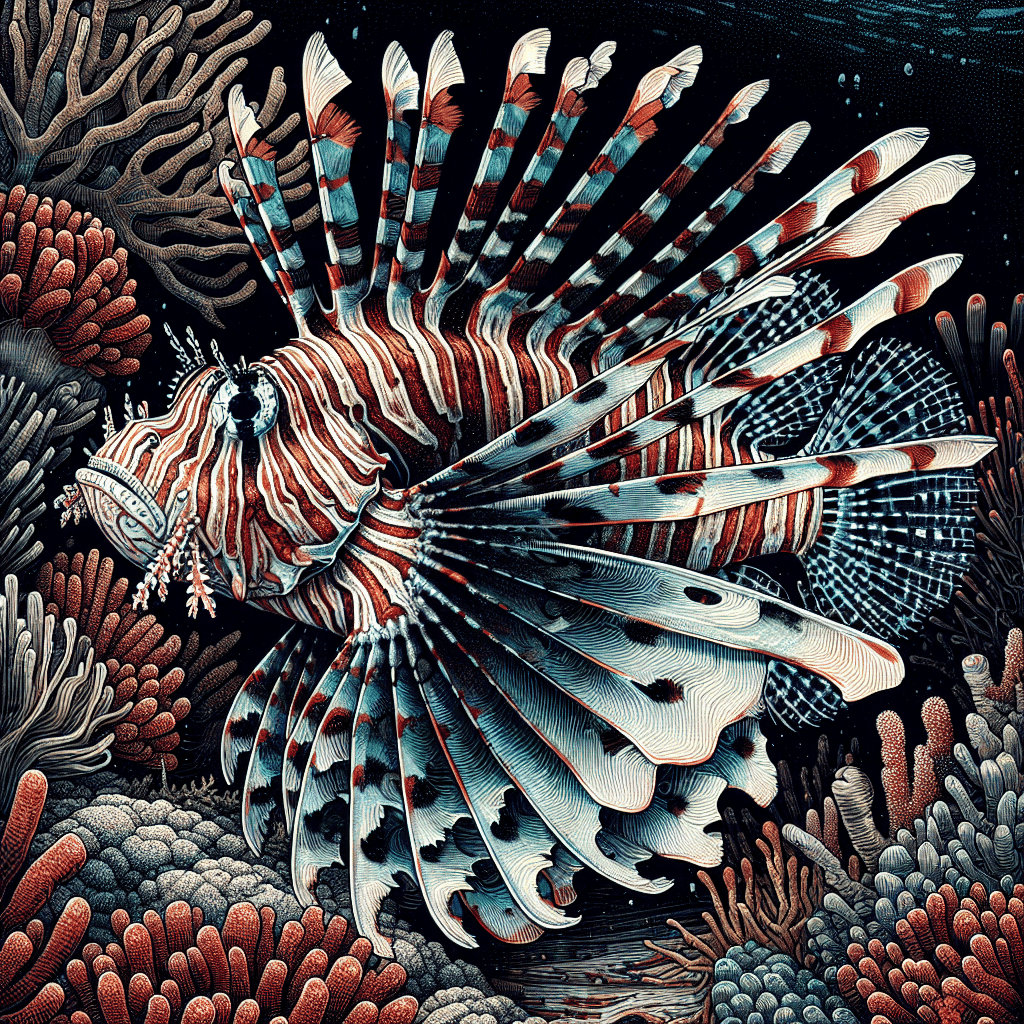Introduction to Clown Triggerfish
Characteristics and Behavior
The clown triggerfish, scientifically known as Balistoides conspicillum, is one of the most fascinating fish I’ve come across in reef tanks. These colorful fish are known for their vibrant patterns and unique features. They have a distinctive body shape with a large, rounded head and a beak-like mouth, which they use to crack open hard-shelled prey. Their coloration is striking, often featuring a combination of black, yellow, and white, making them a favorite among aquarium enthusiasts.
In terms of behavior, clown triggerfish are quite territorial and can exhibit aggressive tendencies, especially towards other tank mates. They are known to establish a defined territory within their environment and will defend it vigorously. This characteristic makes them a bit challenging to keep in a community tank setup, and they prefer to have plenty of space and hiding spots.
Natural Habitat and Distribution
Clown triggerfish are predominantly found in the warm, tropical waters of the Indo-Pacific region. I’ve learned that their distribution includes areas such as the Red Sea, the eastern coast of Africa, the Maldives, and the Hawaiian Islands. They thrive in coral reefs and lagoons that boast rich biodiversity. According to Oceana, these fish mainly inhabit coral and rocky reefs, where they find both shelter and food.
| Region | Notable Locations |
|---|---|
| Indo-Pacific | Red Sea, Maldives, Hawaiian Islands |
| Coastal Areas | Thailand, Australia, South Africa |
Despite their broad distribution, clown triggerfish are relatively uncommon on any given reef. They typically inhabit clear seaward reefs, often near steep drop-offs in coral-rich environments (Waikiki Aquarium). For anyone considering adding a clown triggerfish to their reef tank, it’s important to replicate this natural habitat as closely as possible.
If you’re interested in learning more about other marine fish that can coexist with clown triggerfish, check out articles on triggerfish and marine fish.
Clown Triggerfish Care Guide
Caring for clown triggerfish can be a rewarding experience, especially when you appreciate their vibrant colors and dynamic personalities. Here’s what I’ve learned about their care requirements, including tank size and setup, feeding needs, and compatibility with other tank mates.
Tank Size and Setup
Clown triggerfish are not small fish; they can grow up to 1 foot 8 inches long, which means they need plenty of space to swim. I recommend a tank size of at least 200 gallons to provide adequate swimming room and maintain good water quality.
| Requirement | Details |
|---|---|
| Minimum Tank Size | 200 gallons |
| Filtration | High-quality filtration system |
| Hiding Places | Rocks, caves, and other structures |
Setting up the tank with ample hiding spots will help them feel secure. These fish are also known for their aggressive nature, so keeping a well-maintained environment is crucial.
Feeding Requirements
Feeding clown triggerfish can be an enjoyable part of their care. They are generally carnivorous and enjoy a varied diet. I typically provide them with:
- High-quality pellets
- Frozen or live foods such as shrimp, squid, and fish
- Occasional plant matter
Offering a diverse diet helps maintain their health and vibrant coloration. It’s important to feed them small amounts multiple times a day rather than one large feeding to mimic their natural eating habits.
Tank Mates Compatibility
Choosing the right tank mates for clown triggerfish is critical due to their aggressive temperament. They can be incompatible with small, peaceful, or slow-moving fish and invertebrates. Some suitable tank mates include:
- Groupers
- Large puffers
- Tangs
- Angels
It’s essential to monitor interactions closely, especially when introducing new fish. Clown triggerfish require assertive companions that can handle their aggressive behavior. For more information on compatible species, you might want to explore other fish like grouper or pufferfish.
In summary, with the right tank size, diet, and compatible tank mates, I find that clown triggerfish can thrive beautifully in a well-maintained reef tank. If you’re ready for the challenge, these fish can become a stunning centerpiece in your aquarium.
Clown Triggerfish Appearance
The clown triggerfish is a fascinating species with a striking appearance that changes as it grows. Understanding their juvenile and adult coloration provides insight into their development and beauty.
Juvenile Appearance
When clown triggerfish are young, their appearance is quite distinct. They have a predominantly black body that features a bright yellow snout and back. One of the most eye-catching aspects of their juvenile stage is the white spots that cover the majority of their body. This coloration serves as excellent camouflage in the vibrant coral reefs where they live.
| Age Stage | Body Coloration | Notable Features |
|---|---|---|
| Juvenile | Black with yellow snout and back | White spots covering most of the body |
For hobbyists, understanding this coloration is key when selecting clown triggerfish for their aquariums. These young fish are often easier to feed and integrate into a community tank, as they tend to be less aggressive compared to their adult counterparts.
Adult Coloration
As clown triggerfish mature, their appearance transforms significantly. The vibrant yellow patches seen in juveniles diminish, making room for a unique latticed pattern on their back. This change not only alters their aesthetic but can also influence their behavior in the tank. Adult clown triggerfish can reach an average size of about 20 inches (50 centimeters) in length, making them a noticeable presence in any reef tank.
| Age Stage | Body Coloration | Notable Features |
|---|---|---|
| Adult | Latticed pattern with reduced yellow | Larger size (up to 20 inches) |
The adult coloration of clown triggerfish is striking and adds a dynamic element to reef tanks. They are known for their vibrant personalities, which can make them a favorite among fish tank hobbyists. For more information on keeping clown triggerfish, check out our guide on marine fish and other compatible species like clownfish and tang.
Breeding Behavior of Clown Triggerfish
Clown triggerfish have some fascinating breeding behaviors that I find really interesting. They are oviparous, meaning they lay eggs, and their spawning process is quite unique.
Spawning Process
During courtship rituals, the male clown triggerfish is the first to arrive at a spawning area to establish and defend a small territory. This is crucial because females will choose their mates based on the quality of the territory. Once a female has selected her mate, she will release her eggs into a nest that the male has prepared.
The male then takes on the role of protector, guarding the nest diligently until the eggs hatch. This behavior is essential since clown triggerfish can be quite territorial, especially during spawning. They are known to exhibit increased aggression to ensure the safety of their offspring (Oceana).
| Stage | Description |
|---|---|
| Courtship | Males display to attract females and set up territories. |
| Egg-Laying | Females lay eggs in the male’s nest. |
| Nest Guarding | Males protect the nest until hatching. |
Parental Care
Once the eggs are laid, both the male and female clown triggerfish take part in the care of their young. The male primarily guards the nest, using his territorial instincts to fend off potential threats. This vigilance is crucial as it helps ensure that the eggs remain safe until they hatch.
After the eggs hatch, the young clown triggerfish are relatively independent, but the parental care doesn’t end there. The adults continue to protect their territory from intruders, which helps create a safe environment for their fry as they grow and learn to navigate their surroundings. The combination of strong parental instincts and territorial behavior makes clown triggerfish fascinating to observe during this critical period of their life cycle (Medium, Blessings Aquarium).
If you’re interested in learning more about the clown triggerfish or other marine species, check out articles about marine fish, triggerfish, and the various inhabitants of reef tanks.
Conservation Status of Clown Triggerfish
Rarity in the Wild
The conservation status of the clown triggerfish is currently unknown. However, its rarity in the wild is believed to be a natural occurrence. This means that while they may not be as commonly seen as other fish, it doesn’t necessarily indicate that they are in danger or facing immediate threats. The clown triggerfish is part of the diverse marine ecosystem and plays a role in the balance of its habitat.
| Factor | Details |
|---|---|
| Conservation Status | Unknown |
| Rarity | Likely a natural occurrence |
For more information on marine species and their statuses, you can check out the marine fish section.
Efforts for Conservation
While there aren’t specific conservation efforts dedicated exclusively to the clown triggerfish, protecting their natural habitats is crucial for their survival. Efforts to conserve reef ecosystems indirectly benefit clown triggerfish populations. Healthy reefs provide the necessary environment for these fish to thrive.
Aquarium hobbyists can contribute to conservation by avoiding overfishing and supporting sustainable practices. By purchasing clown triggerfish from reputable sources that prioritize sustainability, hobbyists can help ensure that these unique fish remain part of our oceans. In addition to clown triggerfish, consider the impacts on other species such as lionfish, triggerfish, and grouper that share their habitat.
In conclusion, while the clown triggerfish’s conservation status is uncertain, understanding its rarity and the importance of habitat protection can help promote awareness and actions that support marine life.
Fun Facts about Clown Triggerfish
Unique Adaptations
Clown triggerfish have some pretty fascinating adaptations that help them thrive in their reef environment. One of the most interesting features is their retractable dorsal spine located just behind their eye. This spine allows them to wedge themselves into crevices for protection and a cozy spot to rest at night. When they feel threatened, they can dive into a hole and lock themselves in place using their dorsal spine, making it tough for predators to reach them (Waikiki Aquarium).
Their eyes are also set high on their heads and can move independently. This unique positioning lets them scan their surroundings for food and potential dangers without having to move their bodies. Plus, their strong teeth and powerful jaws allow them to feast on armored reef invertebrates like crustaceans and sea urchins, making them quite the effective predators.
Popular in the Aquarium Trade
Due to their vibrant colors and unique behaviors, clown triggerfish are highly sought after in both public and private aquaria. Their striking appearance and interesting personalities make them a favorite among fish tank enthusiasts. However, it’s essential to note that clown triggerfish often come from the wild, which raises concerns about their sustainability in the aquarium trade (Oceana).
While they can be kept in home aquariums, clown triggerfish require large tanks with plenty of hiding spots and swimming space. They are known to be territorial, especially during mating season, and this aggressive nature means they are not the best choice for beginner aquarists. If you’re interested in learning more about suitable tank mates for clown triggerfish, check out our article on marine fish.
Clown Triggerfish in the Indo-Pacific
Geographic Range
I find it fascinating that the clown triggerfish primarily resides in the warm, tropical waters of the Indo-Pacific region. You can spot these vibrant fish from the coastlines of Thailand all the way to the stunning reefs of Australia and South Africa. They thrive in tropical latitudes of both the Indian and western Pacific oceans, often found in clear, coral-rich areas adjacent to steep drop-offs (Blessings Aquarium).
| Region | Notable Locations |
|---|---|
| Indian Ocean | Coastlines of Thailand, South Africa |
| Pacific Ocean | Coral reefs in Australia |
Though clown triggerfish have a broad distribution, they are relatively uncommon on any single reef. Their preference for clear water and specific habitat conditions means that finding them can sometimes be a bit of a treasure hunt.
Reef Preferences
When it comes to their habitat, clown triggerfish are all about the reefs. They primarily inhabit coral and rocky reefs, which provide both shelter and abundant food sources. Their preference for these environments helps them thrive, as these areas are rich in biodiversity. The clown triggerfish usually favors seaward reefs, which are often found in deeper waters, making them particularly interesting for aquarium hobbyists who want to emulate their natural environment.
Here’s a quick look at their habitat preferences:
| Habitat Type | Description |
|---|---|
| Coral Reefs | Home to diverse marine life, providing food and shelter |
| Rocky Reefs | Offers hiding spots and hunting grounds |
| Clear Waters | Essential for finding food and avoiding predators |
If you’re thinking about adding a clown triggerfish to your reef tank, consider creating a similar environment with ample hiding spots and live rock to mimic their natural habitat. The colorful and lively nature of these fish makes them a great addition to any marine setup. For more insights into other marine species, check out our articles on marine fish and various reef inhabitants like clownfish and pufferfish.
Interaction and Communication of Clown Triggerfish
Swimming Behavior
I find the swimming behavior of clown triggerfish to be quite fascinating. They have a unique way of moving through the water, using waving motions of their broadened dorsal and anal fins. This method allows them to maneuver with ease, enabling them to swim forward, backward, or even hover over the reef. However, they aren’t built for speed. When they need to make a quick escape, they rely on their broom-like tail for short bursts of speed to dash into the safety of the reef (Waikiki Aquarium).
| Swimming Technique | Description |
|---|---|
| Movement | Waving motions of dorsal and anal fins |
| Maneuverability | Excellent for hovering and navigating |
| Speed | Limited; relies on quick dashes for escape |
Defensive Mechanisms
Clown triggerfish have some interesting defensive behaviors that help them stay safe from predators. One notable feature is their high-set eyes, which can move independently. This adaptation allows them to scan their surroundings for food and potential threats. When they sense danger, they have a clever escape plan. They dive into a hole or crevice in the reef and wedge themselves in for safety. Their large dorsal spine, which can be erected, locks into place with a smaller spine behind it, making it difficult for predators to pull them out (Waikiki Aquarium).
| Defensive Mechanism | Description |
|---|---|
| Eye Position | High-set eyes for scanning |
| Evasive Action | Dives into crevices when threatened |
| Locking Mechanism | Dorsal spine secures fish in place |
These traits make clown triggerfish not only unique in their behavior but also quite resilient in the wild. Understanding how they interact and communicate helps me appreciate their role in the reef ecosystem and enhances my experience as a fish tank and reef tank hobbyist. If you’re interested in learning more about other marine species, check out our articles on marine fish and various reef inhabitants like lionfish and triggerfish.



